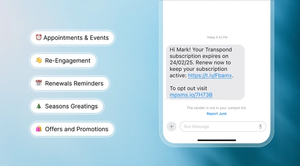Marketing is full of complex terms and it can be hard to keep up with them all. That's where marketing abbreviations come in handy – they're like a secret code to efficiency.
To keep things simple, we’ve put together the ultimate list of marketing abbreviations that you need to know. This easy-to-digest list is here to help you use these terms like a pro.
Whether you're looking to impress your boss, wow your clients, or just make your work life a bit easier, these 100 abbreviations are sure to get you on your way. Let's get abbreviating!
The ultimate list of marketing abbreviations
ABM (Account-Based Marketing)
ABM targets key accounts with personalized campaigns.
AM (Affinity Marketing)
Partnering with companies that offer complementary products or services to your target audience.
AIDA (Attention, Interest, Desire, Action)
This is a four-step purchase funnel in which customers travel from attention to action.
API (Application Programming Interface)
An API is a set of functions and procedures allowing the creation of applications that access the features or data of an operating system, application, or other service.
ATL (Above The Line)
This refers to broad-reach advertising like TV and radio. It’s the megaphone approach, shouting out to as many people as possible.
ATR (Average Time on Page)
This metric reveals how long visitors hang out on a specific page.
B2B (Business to Business)
This refers to a situation where one business makes a transaction with another business.
B2C (Business to Consumer)
B2C is about businesses selling directly to consumers. Typically, if you were to think of a business, you would probably imagine a business selling a product or service.
BANT (Budget, Authority, Need, Timeframe)
A method for qualifying leads. It's like a checklist to determine if a potential client is really a contender.
BOFU (Bottom of the Funnel)
This is where the magic happens in the customer journey. It’s almost the equivalent of a customer stating "I choose you!"
BR (Bounce Rate)
The bounce rate represents the % of visitors who enter the site and then leave (“bounce”) rather than continuing to view other pages within the same site.
BTL (Below The Line)
This is more targeted, like direct mail, sponsorships, and email campaigns. It’s the whisper in the ear rather than the shout across the crowd.
CAC (Customer Acquisition Cost)
The cost associated in convincing a customer to buy a product/service. This cost is incurred by the organization to convince a potential customer.
Churn Rate
The percentage of customers who stop using your service over a certain period.
CLV (Customer Lifetime Value)
CLV is a prediction of the net profit attributed to the entire future relationship with a customer. This metric is important as it enables you to see how much you should invest in acquiring new customers and retaining existing ones.
CMS (Content Management System)
This is a software application used for producing and managing a website. It helps users create, manage, and modify content on a website without needing specialized technical knowledge.
CPC (Cost Per Click)
This is a method used to bill for advertising campaigns where advertisers pay each time a user clicks on their ad. It's a way to measure the cost or price of a specific ad campaign.
CPM (Cost Per Thousand Impressions)
Unlike CPC, CPM is a metric that represents the cost for 1000 impressions of your advertisement. Typically, this metric is commonly used in bidding systems for ad space. You can calculate it using a CPM calculator.
CRM (Customer Relationship Management)
This is the backbone of effective marketing strategies. CRM refers to practices, strategies, and technologies that companies use to manage and analyze customer interactions and data throughout the customer lifecycle. It's all about enhancing customer service relationships and assisting in customer retention and driving sales growth. If you think your company would benefit from a class CRM service, try out Capsule CRM today. Whether you need to automate workflows, manage contacts, track your sales pipeline and many more, try Capsule for free for 14 days.
CRO (Conversion Rate Optimization)
The process of increasing the percentage of users or website visitors to take a desired action, these actions could include making a purchase for example.
CSS (Cascading Style Sheets)
CSS is a style sheet language used for describing the presentation of a document written in HTML or XML. It's what designers use to create the look and general vibe of the website.
CTA (Call to Action)
A CTA is a prompt on a website that tells the user to take some specified action, like 'Sign Up', 'Buy Now', or 'Learn More'. The CTA encourages the audience to do something.
CTR (Click-Through Rate)
CTR is a ratio showing how often people who see your ad end up clicking it. To calculate CTR, simply divide the number of clicks your ad receives by the number of times your ad is shown.
CTV (Connected TV)
The new kid on the advertising block. CTV refers to ads delivered through streaming services on smart TVs. It’s like traditional TV got a tech-savvy younger sibling.
CVR (Conversion Rate)
This is the percentage of visitors to your website that complete a desired goal (a conversion) out of the total number of visitors. A high conversion rate is indicative of successful marketing and web design.
DA (Domain Authority)
A score predicting how well a website will rank on search engines. It's like a credit score, but one given by a website authority checker.
Dark Social
Web traffic that's hard to track, usually coming from private social media shares, emails, or messaging apps. It's the incognito mode of social sharing.
DAU (Daily Active Users)
The number of unique users who engage with your site or app in a day.
DSP (Demand-Side Platform)
This is a system that allows buyers of digital advertising inventory to manage multiple ad exchange and data exchange accounts through one interface.
Earned Media
This is publicity gained through promotional efforts other than paid media advertising, like good old-fashioned word-of-mouth.
EAT (Expertise, Authoritativeness, Trustworthiness)
Google’s criteria for deciding if your content is the cream of the crop.
ESP (Email Service Provider)
The platforms you use to send out those fancy marketing emails. It’s your digital postman.
FOMO (Fear of Missing Out)
The anxiety that an exciting event may currently be happening elsewhere. Marketers use this to create urgency and drive action.
Friction
Any element of your website or user experience that annoys visitors or makes it hard for them to convert. It’s the digital equivalent of a squeaky door hinge.
GA (Google Analytics)
This is a web analytics service offered by Google that tracks and reports website traffic. It's the most widely used web analytics service on the web and helps marketers understand their website audience.
Geo-Targeting
Geo-targeting involves tailoring content or ads to people based on their location.
Growth Hacking
A crucial strategy for startups and agile companies, growth hacking melds creativity, analytics, and social metrics to enhance product sales and exposure. It's about using smart, cost-effective techniques for quick growth and user base expansion.
GTM (Go-To-Market)
This is your battle plan for launching a new product or entering a new market.
HTML (Hypertext Markup Language)
The standard markup language for documents designed to be displayed in a web browser. It's the backbone of any website development process, without which web pages cannot be created.
Hyperlocal Marketing
Focusing your marketing efforts on a small, local area.
Influencer Marketing
Partnering with influencers to promote your brand.
IP Address (Internet Protocol Address):
Every device connected to the internet has one. It’s like the digital home address for your computer.
ISP (Internet Service Provider)
These are the companies that provide us with Internet access. Without them, we’d still be stuck in the dark ages of offline marketing.
Journey Mapping
The process of creating a visual story of your customers’ interactions with your brand.
Keyword Stuffing
Overloading your website content with too many keywords. It’s the digital version of trying to fit into pants that are two sizes too small.
KPI (Key Performance Indicator)
These are quantifiable measures which evaluate the success of an organization, employee, etc., in meeting objectives for performance. In marketing, KPIs are used to track progress toward marketing goals.
Landing Page
The web page where people land after clicking your ad. It’s like the welcome mat of your digital house.
Lookalike Audience
In digital advertising, it’s a group of people who resemble your current customers.
LTV (Lifetime Value)
Similar to CLV, LTV is a forecast of the net profit attributed to the entire relationship with a customer.
MAU (Monthly Active Users)
This counts the number of unique users who engage with your site or app in a month.
Micro-Moments
Times when a consumer turns to a device to act on a need to learn, do, discover, watch, or buy something. They're the impromptu decisions in the digital world.
MOFU (Middle of the Funnel)
The getting-to-know-you phase. Here, you're nurturing your leads.
MQL (Marketing Qualified Lead)
A lead that’s more likely to become a customer compared to other leads. It’s like having a good hand in poker.
Native Advertising
Ads that blend in with their surroundings, like camouflaging chameleons. They match the look, feel, and function of the media format in which they appear.
Netnography
It's like anthropology, but for understanding online communities and cultures. Think of it as being a digital sociologist.
NPS (Net Promoter Score)
NPS is a management tool that can be used to gauge the loyalty of a firm's customer relationships.
Omnichannel Experience
Offering a seamless and consistent interaction across all channels, whether it's in-store, online, or via mobile.
Omnichannel Marketing
Creating a seamless customer experience across all channels and devices. It’s like ensuring your party is rocking, whether guests are in the living room, kitchen, or backyard.
OOH (Out of Home Advertising)
This is the art of reaching people while they're, well, out of their homes. Billboards, bus ads, and those giant signs in Times Square? That's OOH showing off.
Page Authority
A score that predicts how well a specific page will rank on search engines.
PPC (Pay Per Click)
Similar to CPC, PPC is an internet marketing model where advertisers pay a fee each time one of their ads is clicked. Essentially, it's a way of buying visits to your site, rather than attempting to “earn” those visits organically.
PPL (Pay Per Lead)
A pricing model where you pay for each lead generated. It’s like paying for every fish that bites, rather than every fish you see. Programmatic Advertising: Using software to buy digital advertising, as opposed to traditional processes like RFPs, negotiations, and manual insertion orders. It’s like using a smart assistant to do your shopping.
PV (Pageviews)
This refers to the number of times a page is viewed. Repeated views of a single page are counted.
QR Code (Quick Response Code)
A type of matrix barcode (or two-dimensional barcode) first designed in 1994 for the automotive industry in Japan. A barcode is a machine-readable optical label that contains information about the item to which it is attached.
Quality Score
In PPC advertising, it’s a metric that affects ad placement and cost.
Remarketing
It’s showing ads to people who have previously visited your website or used your app. Like saying “Hey, remember me?” to customers who've checked out your product.
RFI (Request for Information)
This is like the pre-game to the RFP (Request for Proposal). It’s when a company is just starting to sniff around but isn’t quite ready to commit.
RFM (Recency, Frequency, Monetary)
A marketing analysis tool used to identify a firm's best customers by measuring certain factors. The RFM model is based on three quantitative factors: Recency, Frequency, and Monetary value.
RFP (Request for Proposal)
When a company wants to buy something big, they issue an RFP. It’s like sending out a bat signal to potential suppliers. ROAS (Return on Ad Spend): It tells you how many dollars you’ve earned for every dollar spent on advertising. It’s like checking how much bang you got for your buck.
ROI (Return on Investment)
ROI measures the profitability of an investment. In marketing, it's used to evaluate the effectiveness of a campaign, comparing the net profit to the cost. It's like a report card for your marketing efforts, telling you how well your investment is performing.
RSS (Really Simple Syndication)
RSS is a type of web feed that allows users and applications to access updates to websites in a standardized, computer-readable format.
SaaS (Software as a Service)
This refers to a software distribution model in which a third-party provider hosts applications and makes them available to customers over the Internet. It eliminates the need for organizations to install and run applications on their own computers or in their own data centers.
Schema Markup
A code that you put on your website to help search engines return more informative results for users. It’s like giving search engines a cheat sheet about your site.
SEM (Search Engine Marketing)
Think of SEM as a broader discipline that incorporates SEO. It involves using paid strategies to increase search visibility. Businesses leverage paid ads on search engines like Google to reach potential customers. It's like placing a strategically designed billboard on the digital highway where your target audience travels.
SEO (Search Engine Optimization)
This is the art and science of getting pages to rank higher in search engines such as Google. It involves optimizing content, improving site structure, and building quality backlinks. In the ever-evolving world of digital marketing, mastering SEO is like having a golden key to unlock massive organic traffic.
SERP (Search Engine Results Page)
When you search for something on Google, the page that shows up with all the results is the SERP. It lists the search results, paid ads, featured snippets, and other data specific to your query.
SLA (Service Level Agreement)
This is the promise you make to your customers about the level of service they can expect.
SMB (Small and Medium-sized Businesses)
SMBs are businesses whose personnel numbers fall below certain limits. The abbreviation “SME” is also used for small and medium enterprises.
SMM (Social Media Marketing)
SMM refers to the use of social media platforms and websites to promote a product or service. SMM involves creating tailored content for each social media platform to drive engagement and sharing.
SWOT (Strengths, Weaknesses, Opportunities, Threats)
A strategic planning technique used to help a person or organization identify strengths, weaknesses, opportunities, and threats related to business competition or project planning.
Target Audience
The specific group of people you want to reach with your advertising.
TLD (Top-Level Domain)
The part of the web address that comes after the dot, like .com, .org, or .pizza (yes, that’s real).
TOFU (Top of the Funnel)
This is your first interaction with potential customers. This main part of this bit of the funnel is creating awareness.
UGC (User-Generated Content)
UGC refers to any form of content - like videos, blogs, forum posts, reviews, social media posts - that has been created and put out there by unpaid contributors.
UI (User Interface)
The UI is the point of human-computer interaction and communication in a device. This can include display screens, keyboards, a mouse and the appearance of a desktop.
User Persona
A semi-fictional character based on your ideal customer. This way you can target who matters.
UX (User Experience)
This refers to a person's emotions and attitudes about using a particular product, system, or service. The user experience is something which includes the practical, experiential, affective, meaningful, and valuable aspects of human-computer interaction and product ownership.
Viral Marketing
A strategy that encourages individuals to pass on a marketing message to others, creating the potential for exponential growth. It's the dream of every marketer.
VOD (Video on Demand)
A media distribution system that allows users to access videos without a traditional video playback device and the constraints of a typical static broadcasting schedule.
Webinar
An online seminar or workshop.
WOMM (Word of Mouth Marketing)
The oldest trick in the book. It’s when people talk about your product because they genuinely love it, WOMM is a great way to gain valuable customers.
XML (eXtensible Markup Language)
A language for documents containing structured information. It’s like HTML’s cousin, but used for transporting and storing data.
XML Sitemap
A file that helps search engines understand your website while crawling it. It’s like a map for Google’s bots to navigate your site.
Yield Management
A strategy in which prices are continuously adjusted based on real-time supply and demand. It’s like playing the stock market, but with your product prices.
YOY (Year Over Year)
This compares stats from one year to the same period in the previous year. It’s like looking at last year’s photo album to see how much you’ve grown.
YTD (Year to Date)
It’s like looking at your business’s report card partway through the year. It tells you how you’re doing from January 1st up to today.
Zero-Based Budgeting (ZBB)
A budgeting method where all expenses must be justified for each new period. It's like starting your monthly budget from scratch, considering each expense as if it’s the first time
ZMOT (Zero Moment of Truth)
The moment when a consumer researches a product before buying. It’s the digital 'think before you buy.'
Wrapping up
From SEO to CTR, understanding marketing abbreviations is essential in helping you build a wider marketing strategy. It’s not just about keeping up with the jargon. It’s a way of staying ahead in a rapidly evolving digital landscape, where brevity and clarity are key.
Communication is key in business. That’s why so many businesses invest in software to improve their professional relationships. Discover how Capsule can help you build better customer relationships with our free 14 day trial.




